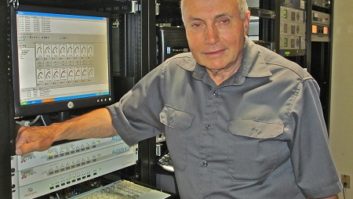
Warren Shulz, shown at the base of the WLS(AM) tower. I believe EAS as we know it should be removed from the public broadcast arena. It is nonfunctional and gives the public and government a false sense of security.
As Frank McCoy pointed out in a recent commentary (“Take EAS Back to the Drawing Board,” radioworld.com, keyword McCoy), the “spoofing” vulnerabilities run even deeper than have been reported. A low-power transmitter can be linked into a Local Primary entry point to open the gate with the Emergency Action Notification header code, deliver an audio message and lock up an operational area for hours. We saw that in June 2007 when the Federal Emergency Management Agency conducted a closed-circuit test that leaked to air via the Illinois Emergency Operations Center.
I was Illinois state EAS chair at the time. A day after the erroneous test, I received a call from the state of Missouri EOC because an unattended station was still linked to its monitor assignment. The leaked test had included the EAN header but had then been aborted; thus, no audio or end-of-message data. Bad choice. The EAN header by itself provides for an immediate takeover yet carries no time-out code.
It’s one thing to send a distorted message. It would be a whole other thing to repeat WGN audio over WLS!
Too many silos
FEMA planners continue to dump millions into an AM emergency backbone that has a diminishing number of listeners and an aging base of receivers.
What nationwide alert would require immediate alarm yet not be carried by CNN, CNBC, the Internet and general news reporting agencies? The concept has aged out. We have been awaiting a presidential message, over an untested system, since 1951.
When I served on the board of the Primary Entry Point Advisory Committee, a White House representative asked when the last end-to-end test had been done. An uncomfortable question; we could report only polling tests, there had never been an end-to-end test. That was 2003. It took another eight years and a lot of conversations to get to the nationwide test of November 2011. And that flawed test showed how ill-prepared the system is.
Government agencies operate in a silo fashion. In my experience, alert center folks don’t communicate with FEMA folks; White House communications people don’t communicate with FEMA planners. EAS responsibilities span some nine federal agencies, give or take, creating a snake without a head. NOAA Weather Radio is an excellent, paid-for solution, but it is another silo without a link to the Federal Alert Center.
EAS won’t work unless an EAS czar is appointed to coordinate the overall system; and that’s not going to happen.
Fifty solutions
At the end of my tour as state chair, I would tell people at the station level to do only what was required and no more, because EAS is driven by a series of presidential executive orders, which by nature are open-ended statements subject to interpretation.
What is required? Conduct weekly tests, initiated at the station level (radio/TV/cable), data burst only. … Monitor two assigned stations for the statewide monthly test, with audio message, and relay a monthly test from the state entry point. … Keep a record of tests sent and received. … Post the state plan. …. Be at the ready to air a presidential alert.
That’s what’s required; anything after that is “voluntary participation.”
Further muddying things, a state plan must be prepared by a volunteer EAS committee. It’s up to that committee to work out the mechanics to link the state entry point to a Primary Entry Point station or NPR station that sources the EAN alert. You have 50 state plans in the works, developed by volunteers receiving little direction or review.
You may recall the six EAS “summits” subsidized by the NAB and supported by the National Alliance of State Broadcasting Associations. Most of the discussions ended up going no place. The FCC sucked in comment after comment; the whole rewrite of Part 11 went full circle. Yet only the Internet component CAP was added; and the industry spent millions of dollars to add that component. Otherwise, the system is as it was.
In the meantime the delivery system has aged out and terrestrial radio is no longer in the eye of the public. Best Buy removes radios from the showroom; car guys pull AM and FM sections out of car audio systems in favor of WiFi hot spots. The testing now being aired has a hollow meaning, giving comfort only to regulators.
Oddly, NOAA Weather Radio is a manned operation that reaches EAS encoder/decoders at most radio, TV and cable stations. Yet it is not used beyond weather alerts. In Illinois we did convince NOAA Weather Radio to carry Amber Alerts. It gets the message to radio/TV/cable quickly over the analog VHF channel. Not high-tech, no Internet, no glamour. And it’s not in the FEMA, FCC or FOC silos, so it is not deployed.
My point is that EAS cannot be fixed and should be closed down. Rely on cellphone text alerts. If desired, reserve the EAS radio daisy chain for long-form messages. But the system threads its way over so many federal agencies that I don’t think it can ever be untangled. Without routine end-to-end testing its operational readiness is an unknown. Its power began with President Truman and CONELRAD in 1951, preparing for an event that never happened. Sixty-two years later we are still preparing.
The author is former engineer of WLS(AM) and was for 16 years the state EAS chair in Illinois. He is now retired.
Comment on this or any story. Email [email protected] with “Letter to the Editor” in the subject field.










